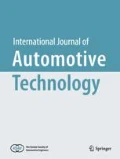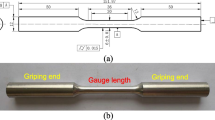Abstract
Transformation-induced plasticity (TRIP) steels are part of advanced high strength steels capable of phase transformation, having good strength and ductility. The transformation rate is known to be dependent on the stress state, which may lead to asymmetric hardening behaviour for TRIP steels with compressive flow stresses larger than tensile ones. Sheet stamping products of TRIP steels show complex springback because of the asymmetry in addition to the large strength, which will complicate the analysis of sheet metal forming processes. In this work, the asymmetric hardening behaviour of a TRIP steel with a tensile strength of 1180 MPa was measured using the sheet tension-compression tester. An asymmetric hardening model was developed by introducing an off-centred bounding surface for the kinematic back-stress evolution, to depict the asymmetric hardening behaviour. The model parameters of the proposed constitutive equations were obtained from the stressstrain curves under tension followed by compression. The stress-strain curves were well captured by the developed constitutive model, whereas the conventional symmetric model fails to describe the asymmetric hardening behaviour of the TRIP steel. For validation, load-displacement curve and springback angles of three-point bending test were compared with the predictions by the proposed model.
Similar content being viewed by others
Abbreviations
- E :
-
instantaneous Young’s modulus
- \(\overline \varepsilon\) :
-
equivalent plastic strain
- E 0 :
-
initial Young’s modulus of chord modulus model
- E a :
-
saturated Young’s modulus of chord modulus model
- ξ :
-
material parameter of chord modulus model
- r b :
-
plastic strain ratio of balanced biaxial test
- m :
-
exponent parameter of Yld2000-2d model
- α 1∼8 :
-
material parameter of Yld2000-2d model
- ε :
-
logarithmic strain tensor
- C :
-
stiffness matrix
- v :
-
poisson’s ratio
- f :
-
yield function
- \(\overline \sigma\) :
-
effective stress
- σ :
-
cauchy stress tensor
- a :
-
back-stress tensor or center of yield surface
- \({\overline \sigma_{{\rm{iso}}}}\) :
-
size of yield function
- K :
-
material parameter of size of yield function
- \({\overline \varepsilon_{\rm{0}}}\) :
-
material parameter of size of yield function
- n :
-
material parameter of size of yield function
- C :
-
material parameter of Chaboche model
- γ :
-
material parameter of Chaboche model
- β :
-
center of bounding surface
- c :
-
material parameter of center of bounding surface
- K :
-
material parameter of size of yield function
- θ before :
-
angle before springback in 3-point bending
- θ after :
-
angle after springback in 3-point bending
- Δθ :
-
angle difference in three-point bending
- L :
-
length of a beam
- b :
-
width of a beam
- h :
-
height of a beam
- M :
-
moment
- R :
-
distance from neutral plane of beam to center of curvature
- Y :
-
yield strength
- δ :
-
degree of asymmetry
- κ 0 :
-
maximum curvature
- κ * :
-
springback amount
- e :
-
elastic
- p :
-
plastic
- 1, 2:
-
direction
- T :
-
tension
- C :
-
compression
- Max :
-
maximum
- s :
-
symmetry
- a :
-
asymmetry
References
ASTM INTERNATIONAL (2016). Standard Test Method for Tension Testing of Metallic Materials.
ASTM INTERNATIONAL (2018). Standard Test Method for Plastic Strain Ratio r for Sheet Metal.
Barlat, F., Brem, J. C., Yoon, J. W., Chung, K., Dick, R. E., Lege, D. J., Pourboghrat, F., Choi, S. H. and Chu, E. (2003). Plane stress yield function for aluminium alloy sheets - Part 1: Theory. Int. J. Plasticity 19, 9, 1297–1319.
Beese, A. M. and Mohr, D. (2011). Effect of stress triaxiality and lode angle on the kinetics of strain-induced austenite-to-martensite transformation. Acta Materialia 59, 7, 2589–2600.
Chaboche, J. L. (1986). Time-independent constitutive theories for cyclic plasticity. Int. J. Plasticity 2, 2, 149–188.
Frederick, C. O. and Armstrong, P. J. (1966). A mathematical representation of the multiaxial bauschinger effect. Material at High Temperatures 24, 1, 1–26.
Garion, C., Skoczen, B. and Sgobba, S. (2006). Constitutive modelling and identification of parameters of the plastic strain-induced martensitic transformation in 316 L stainless steel at cryogenic temperatures. Int. J. Plasticity 22, 7, 1234–1264.
Geng, L. and Wagoner, R. H. (2002). Role of plastic anisotropy and its evolution on springback. Int. J. Mechanical Sciences 44, 1, 123–148.
Maeda, T., Noma, N., Kuwabara, T., Barlat, F. and Korkolis, Y. P. (2018). Measurement of the strength differential effect of DP980 steel sheet and experimental validation using pure bending test. J. Materials Processing Technology, 256, 247–253.
Hanabusa, Y., Takizawa, H. and Kuwabara, T. (2013). Numerical verification of a biaxial tensile test method using a cruciform specimen. J. Materials Processing Technology 213, 6, 961–970.
Hazar, S., Alfredsson, B. and Lai, J. (2018). Mechanical modelling of coupled plasticity and phase transformation effects in a martensitic high strength bearing steel. Mechanics of Materials, 117, 41–57.
Hecker, S. S., Stout, M. G., Straudhammer, K. P. and Smith, J. L. (1982). Effects of strain state and strain rate on deformation-induced transformation in 304 stainless steel: Part I. Magnetic measurements and mechanical behaviour. Metallurgical Trans. A 13, 4, 619–626.
Hur, Y. C., Kim, D., Lee, K. S., Bae, M. G., Park, S. E. and Kim, J. H. (2018). Simulation of self-piercing riveting of advanced high strength steel and aluminum alloy sheet. Proc. AEPA2018, Jeju, Korea.
Iwamoto, T., Tsuta, T. and Tomita, Y. (1998). Investigation on deformation mode dependence of strain-induced martensitic transformation in TRIP steels and modelling of transformation kinetics. Int. J. Mechanical Science 40, 2–3, 173–182.
Jung, J. (1981). A note on the influence of hydrostatic pressure on dislocations. Philosophical Magazine A 43, 4, 1057–1061.
Jung, J., Jun, S., Lee, H.-S., Kim, B.-M., Lee, M.-G. and Kim, J. H. (2017). Anisotropic hardening behaviour and springback of advanced high-strength steels. Metals 7, 11, 480.
Karaman, I., Sehitoglu, H., Maier, H. J. and Balzer, M. (1998). Stress-state effects on the stress-induced martensitic transformation of carburized 4320 steels. Metallurgical and Material Trans. A 29, 2, 427–437.
Kim, H., Lee, J., Barlat, F., Kim, D. and Lee, M.-G. (2015). Experiment and modeling to investigate the effect of stress state, strain and temperature on martensitic phase transformation in TRIP-assisted steel. Acta Materialia, 97, 435–444.
Kim, J. H., Kim, D., Lee, Y. S., Lee, M. G., Chung, K., Kim, H. Y. and Wagoner, R. H. (2013). A temperature-dependent elasto-plastic constitutive model for magnesium alloy AZ31 sheets. Int. J. Plasticity, 50, 66–93.
Lebedev, A. A. and Kosarchuk, V. V. (2000). Influence of phase transformations on the mechanical properties of austenitic stainless steels. Int. J. Plasticity 16, 7–8, 749–767.
Lee, M. G., Kim, J. H., Kim, D., Seo, O. S., Nguyen, N. T. and Kim, H. Y. (2013). Anisotropic hardening of sheet metals at elevated temperature: Tension-compressions test development and validation. Experimental Mechanics 53, 6, 1039–1055.
Nelder, J. A. and Mead, R. A. (1965). Simplex method for function minimization. Computer J. 7, 4, 308–313.
Yan, Y. H., Kai, G. Y. and Jian, M. D. (2006). Transformation behavior of retained austenite under different deformation modes for low alloyed TRIP-assisted steels. Materials Science and Engineering: A 441, 1–2, 331–335.
Olson, G. B. and Cohen, M. (1982). Stress-assisted isothermal martensitic transformation: Application to TRIP steels. Metallurgical Trans. A 13, 11, 1907–1914.
Spitzig, W. A., Sober, R. J. and Richmond, O. (1976). The effect of hydrostatic pressure on the deformation behavior of maraging and HY-80 steels and its implications for plasticity theory. Metallurgical Trans. A 7, 11, 1703–1710.
Stoughton, T. B. and Yoon, J. W. (2009). Anisotropic hardening and non-associated flow in proportional loading of sheet metals. Int. J. Plasticity 25, 9, 1777–1817.
Tomita, Y. and Iwamoto, T. (2001). Computational prediction of deformation behavior of TRIP steels under cyclic loading. Int. J. Mechanical Science 43, 9, 2017–2034.
Yoshida, F. and Uemori, T. (2002). A model of large-strain cyclic plasticity describing the Baushinger effect and work hardening stagnation. Int. J. Plasticity 18, 5–6, 661–686.
Acknowledgement
This work was supported by the Small and Medium Business Administration of Korea (SMBA) grant funded by the Korean government (MOTIE) (No. S2315965) and the National Research Foundation of Korea (NRF) grant funded by the Korean government (MSIP) (2012R1A5A1048294) and the Ministry of Science and ICT (2015R1C1A1A01051620).
Author information
Authors and Affiliations
Corresponding author
Additional information
Publisher’s Note
Springer Nature remains neutral with regard to jurisdictional claims in published maps and institutional affiliations.
This paper was significantly extended and modified from the original paper presented in Asia-Pacific Symposium on Engineering Plasticity and its Applications 2018, and recommended by the Scientific & Technical Committee for journal publication.
Rights and permissions
About this article
Cite this article
Jung, J., Hur, Y.C., Jun, S. et al. Constitutive Modeling of Asymmetric Hardening Behavior of Transformation-Induced Plasticity Steels. Int.J Automot. Technol. 20 (Suppl 1), 19–30 (2019). https://doi.org/10.1007/s12239-019-0124-6
Received:
Revised:
Accepted:
Published:
Issue Date:
DOI: https://doi.org/10.1007/s12239-019-0124-6




